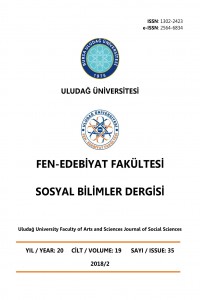Abstract
Buddhist kültüre ait oldukça önemli
unsurları içerisinde barındıran Acanta mağaralarının tarihi, MÖ 2. yüzyıla
kadar gitmektedir. Bu mağaralar, oluşturuldukları dönem itibarıyla ikiye
ayrılmaktadır. Birinci grup, MÖ 2-1. yüzyıllar arasında oluşturulmuşken; ikinci
grup ise yaklaşık olarak dört yüz yıl süren bir aranın ardından, MS 4-6.
yüzyıllar arasında oluşturulmuştur. Tarihsel süreçte birinci grup olarak
adlandırılan mağaralar, Buddhizm’in Hīnayāna mezhebi inanırları tarafından
kullanılmış, ikinci grup ise Mahāyāna mezhebinin manastırları olarak hizmet
vermiştir. Yapısal ve şekilsel özellikleri bakımından da ikiye ayrılan Acanta
mağaralarının, yirmi beşi vihāra, beşi ise çaitya formunda inşa edilmiştir.
Çalışmamıza konu olan çaitya-grihaların içerisinde birer küçük stūpa
bulunmaktadır. Stūpalar, Buddhist kültüre ait oldukça kıymetli ipuçlarını
günümüze taşımaktadır. Bu sebeple çalışmamızda, Acanta’daki çaityaların yapısal
ve kültürel özellikleri incelenerek, Hint kültüründeki yeri ve önemi konusuna
vurgu yapılmak istenmiştir.
References
- Upadhya, D. Om (1994). The Art of Ajanta and Sopocani. Delhi: Motilal Banarsidass Publications.
- Smith, Vincent A. (1930). A History of Fine Art in India&Ceylon. Oxford: The Clarendon Press.
- Singh, Madanjeet (1965). Ajanta, Ajanta Painting of the Sacredand The Secular. New York: The Macmillan Company Press.
- Rowland, Benjamin (1963). The Ajanta Caves Early Buddhist Paintings From India. New York: United Nations Education, Scientificand Cultural Organization Mentor-Unesco Art Books.
- Mitra, Debala (2003). Ajanta. Delhi: Archaeological Survey of India.
- Kaya, Korhan (2017). Buddhizm Sözlüğü. Ankara: Doğu Batı Yayınları.
- Hastings, James (1908). “Ajanta”. Encyclopaedia of Religion and Ethics. C. 1, Edinburgh: T&T Clark, ss. 257-258.
- Fergusson James ve James Burgess (1988). The Cave Temples of India. Delhi: Munshiram Manoharlal Pvt. Ltd.
- Ahir, D. C. (2000). The Influence of Jatakas on Art and Literature. Delhi: B. R. Publishing Cooperation.
- Agrawal, Naidu vd. (2016). “AjantaCaves: A Perspective on Construction Methodsand Techniques”. International Journal of Research in Engineeringand Technology, C. 5, S.9, ss. 217-223. [Erişim Tarihi: 07.01.2018]
- Wiener, Sheila (1977). Ajantaits Place in Buddhist Art, London: University of California Press.
Abstract
Buddhist cultural elements, goes as far as tothe 2nd century BC. The caves are divided
into two periods according to the period when they were created. The first group
was created in 2nd-1st. centuries BC while the second group, after an interval
of approximately four hundred years, was created in 4th-6th. Centuries AD. The caves,
which are called the first group in history, were used by Buddhism's Hīnayāna sect
believers. On the other hand, the second group served as monasteries of
Mahāyāna sect. In terms of its structural and morphological features, Acanta caves
are gain divided into two, twenty-five of the mare built in the form of vihāra and
the other five are built in the form of çaitya. There is a small stupa in
Çaitya-Grihas which is the subject of this study. Stūpas brings a grea tamount
of Buddhist cultural treasure to our day. For this reason, in our study, by examining
the structural and cultural features of the cottages in Acanta; it was aimed to
emphasize their place and importance in Indian culture.
References
- Upadhya, D. Om (1994). The Art of Ajanta and Sopocani. Delhi: Motilal Banarsidass Publications.
- Smith, Vincent A. (1930). A History of Fine Art in India&Ceylon. Oxford: The Clarendon Press.
- Singh, Madanjeet (1965). Ajanta, Ajanta Painting of the Sacredand The Secular. New York: The Macmillan Company Press.
- Rowland, Benjamin (1963). The Ajanta Caves Early Buddhist Paintings From India. New York: United Nations Education, Scientificand Cultural Organization Mentor-Unesco Art Books.
- Mitra, Debala (2003). Ajanta. Delhi: Archaeological Survey of India.
- Kaya, Korhan (2017). Buddhizm Sözlüğü. Ankara: Doğu Batı Yayınları.
- Hastings, James (1908). “Ajanta”. Encyclopaedia of Religion and Ethics. C. 1, Edinburgh: T&T Clark, ss. 257-258.
- Fergusson James ve James Burgess (1988). The Cave Temples of India. Delhi: Munshiram Manoharlal Pvt. Ltd.
- Ahir, D. C. (2000). The Influence of Jatakas on Art and Literature. Delhi: B. R. Publishing Cooperation.
- Agrawal, Naidu vd. (2016). “AjantaCaves: A Perspective on Construction Methodsand Techniques”. International Journal of Research in Engineeringand Technology, C. 5, S.9, ss. 217-223. [Erişim Tarihi: 07.01.2018]
- Wiener, Sheila (1977). Ajantaits Place in Buddhist Art, London: University of California Press.
Details
| Primary Language | Turkish |
|---|---|
| Subjects | Creative Arts and Writing |
| Journal Section | Articles |
| Authors | |
| Publication Date | July 31, 2018 |
| Published in Issue | Year 2018 Volume: 19 Issue: 35 |

This work is licensed under a Creative Commons Attribution 4.0 International License.


